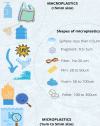Microplastics in mangroves and coral reef ecosystems: a review
- PMID: 34642583
- PMCID: PMC8495182
- DOI: 10.1007/s10311-021-01326-4
Microplastics in mangroves and coral reef ecosystems: a review
Abstract
Microplastic pollution has recently been identified as a major issue for the health of ecosystems. Microplastics have typically sizes of less than 5 mm and occur in various forms, such as pellets, fibres, fragments, films, and granules. Mangroves and coral reefs are sensitive and restricted ecosystems that provide free ecological services such as coastal protection, maintaining natural cycles, hotspots of biodiversity and economically valuable goods. However, urbanization and industrial activities have started contaminating even these preserved ecosystems. Here we review sources, occurrence, and toxicity of microplastics in the trophic levels of mangrove and coral reef ecosystems. We present detection methods, such as microscopic identification and spectroscopy. We discuss mitigating measures that prevent the entry of microplastics into the marine environment.
Keywords: Coral reefs; Ecosystems; Mangroves; Microplastics; Pollution; Toxicity.
© The Author(s), under exclusive licence to Springer Nature Switzerland AG 2021.
Conflict of interest statement
Conflict of interestThe authors declare that they have no conflict of interests.
Figures



References
-
- aber M, Marinković M, de Valk E, Waaijers-van der Loop SL (2021) Paints and microplastics exploring recent developments to minimise the use and release of microplastics in the Dutch paint value chain. 10.21945/RIVM-2021-0037
Publication types
LinkOut - more resources
Full Text Sources
